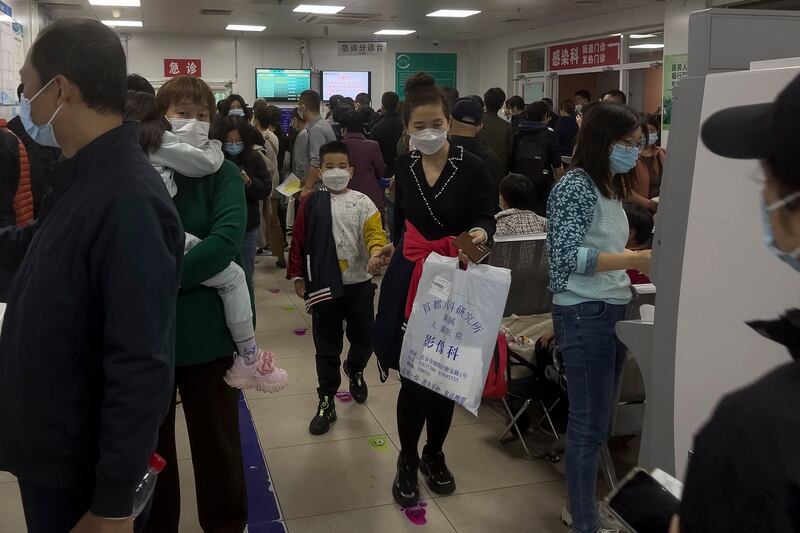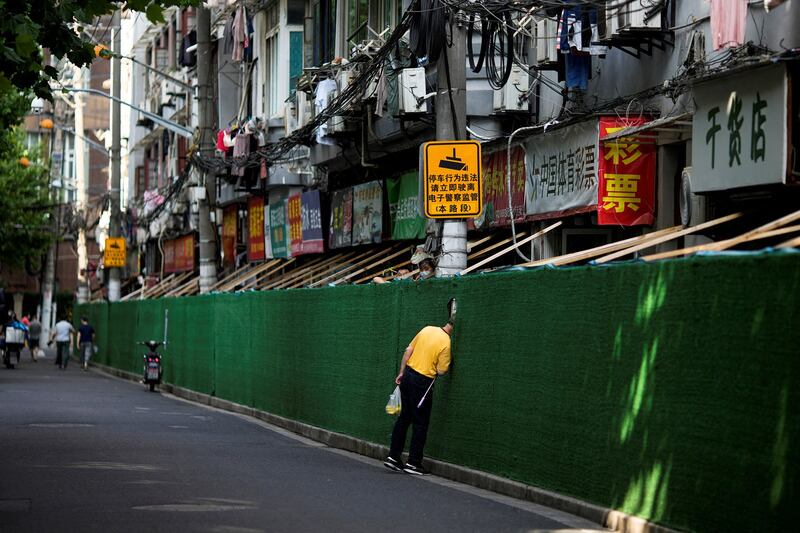Updated at 8:35 am on Dec. 5, 2023
Chinese censors have deleted a news report investigating claims that local governments had brought back a hated disease-tracking app that was used during the "zero-COVID" era to confine people to their homes, amid an ongoing wave of respiratory infections across the country, according to local media reports and residents.
The Dec. 1 Top News article cited social media posts across China as saying that local governments in Sichuan and Guangdong had both brought the app back online after retiring it following the lifting of three years of harsh COVID restrictions in December 2022, with users posting screenshots of their "green" health code from the app.
While the article remained visible in syndicated form on Sohu.com’s mobile website on Monday, it had disappeared from the Top News website.
Guangzhou officials told the news service that some aspects of the app had never been retired, but that the app's ability to impose travel restrictions on individuals had been shut down in February and never reactivated.
The article also reported that the Tianfu Health Pass app in the southwestern province of Sichuan was once more showing a green code, according to residents who checked the government app.
‘Physiological nausea’
The deletion of the article, which was also picked up by several media organizations outside mainland China, comes as hospitals in China struggle to cope with a wave of respiratory disease, much of it among children.
The reports highlight public concerns that restrictive measures may make a comeback, as some suspect that the current pneumonia wave is being driven in the background by COVID-19, which affects people's ability to fight off opportunistic infections like mycoplasma pneumonia, and which has been associated with waves of other respiratory infections in children.

"I hope this will never happen again in my lifetime," commented Weibo user @uuk20_fca from Guangdong, while blogger Lao Xiaoza commented in a post to the China Digital Times that "there is no smoke without a fire."
"When I saw this, my first reaction was physiological nausea," the blogger wrote. "Don’t tell me how this great invention of digital governance has protected everyone’s health. I will never accept this account, no thanks."
Another blogger on the same site, Qinghui Youmo, posted a number of screenshots of reappearing health codes from social media users across China, including Zhejiang, Tianjin, Hebei, Guangxi and Shaanxi.
"Don't scare me like that – I'm close to tears," commented @YipingXuzijiang in a screenshot posted in the blog post.
Wave of sickness
The concerns come as a wave of respiratory disease sweeps across the country, prompting reported class closures amid official warnings of growing cases of influenza, mycoplasma pneumonia, respiratory syncytial virus and COVID-19.
The World Health Organization called on Beijing to share its data on an outbreak in Beijing and Tianjin that made international headlines last week.
Later media reports dismissed people’s concerns about the return of the Health Code app, citing officials as saying that the app had never entirely been taken offline, because it offers other health data services in addition to COVID-19 tracking and tracing.
However, sporadic reports of compulsory COVID-19 testing have also emerged on social media in recent days, including at a conference in Guangzhou, according to Qinghui Youmo’s blog post.
A staff member at Shanghai Pudong International Airport who gave only the surname Ma for fear of reprisals said incoming passengers are being tested for COVID-19 on arrival.
"They say incoming passengers are being randomly tested, but I actually saw an entire flight being tested for COVID," the person said. "A friend of mine flew to Australia yesterday, and they were spraying the plane with disinfectant."
"Health codes have already started coming back online in various places," they said.

A nurse at a hospital in the central city of Wuhan, who gave only the surname Sun, said health codes are being reactivated in some parts of the country, including Fujian, Guangdong, Shaanxi and Sichuan.
"Mycoplasma pneumonia is very serious now, and health codes have been resumed in some areas of Fujian, Guangdong, Shaanxi, and Sichuan," she said. "The wave of mycoplasma pneumonia started in children and then started to spread, just like COVID-19 did back then."
"Now you have to line up for seven or eight hours to get anti-inflammatory shots at the hospital," she said.
Sichuan hit hard
A resident of Sichuan's provincial capital Chengdu, who gave only the surname Jiang, said Sichuan has been particularly hard hit.
"The outbreak in Sichuan is particularly serious – the hospital corridors are full of patients," he said. "A lot of people can't even get admitted to hospital."
But he was skeptical about the reports of the return of health codes, saying: "I don't think so."
The ongoing concern about health tracking came as authorities in Zhejiang's Yiwu city sent out a directive requiring urban and rural residents to stockpile grain, and maintain enough to feed everyone for 10 days.
"All departments and work canteens should maintain a large stock of grain in storage, equal to the average consumption over a 15-day period from the previous year," the directive, which was widely posted online, said.
The reports also sparked concern that the authorities are quietly readying themselves for a return to lockdown measures in a bid to stem the spread of infectious diseases.
The authorites on Dec. 1 also added several newly developed COVID-19 vaccines to their list of medicines approved for emergency use, according to the Chinese financial news website CLS.
National Health Commission spokesperson Mi Feng said on Sunday that the current outbreak is being caused by known pathogens, and called on people to wear masks and wash their hands.
Chinese health authorities are "actively monitoring and assessing winter respiratory diseases," and that outpatient clinics will start operating round the clock to meet demand for treatment, Mi said.
Measures are also being taken to ensure the supply of influenza and other vaccines, with a focus on early vaccination for key groups such as the elderly and children to reduce the risk of illness, Mi said in comments quoted by state news agency Xinhua.
A Guangzhou-based lawyer who declined to be named for fear of reprisals said public opinion in China is divided over the cause of the current wave of sickness, but few believe that the government is giving them the whole story.
"Privately, everyone believes that [these cases] are either sequelae from COVID-19 infections, or that they've been caused by [ China's homegrown] vaccines," the lawyer said, in a reference to public mistrust of vaccines following a number of public health scandals in which children died or were otherwise harmed by fake or incorrectly stored vaccines.
Some medical journals have reported coinfection with COVID-19 and Mycoplasma pneumoniae, while others have pointed to weakened immunity from infection and reinfection with COVID-19.
Translated by Luisetta Mudie. Edited by Malcolm Foster.
Updated to correct attribution in 7th paragraph from end to the Chinese financial news website CLS.
